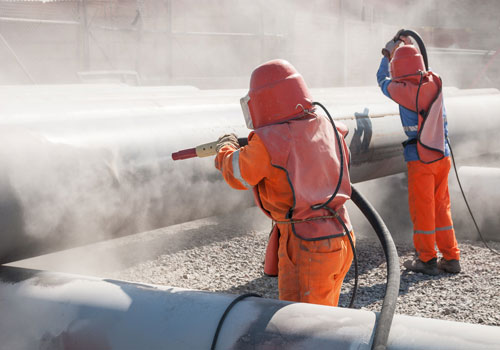
How do you prepare for sandblasting?, Sandblasting is a highly effective technique used to clean, smooth, or prepare surfaces by forcibly propelling abrasive materials against them. It is widely employed in various industries, from automotive and construction to manufacturing and restoration. Proper preparation for sandblasting is crucial to ensure not only the success of the project but also the safety of the individuals involved.
Step by step How do you prepare for sandblasting?
Preparing for sandblasting is a crucial step to ensure the safety of the operators, protect the surrounding environment, and achieve effective results. Here’s a step-by-step guide on How do you prepare for sandblasting by CLC company.
Assess the Work Area
When assessing a work area for sandblasting and painting, it is essential to focus on safety, efficiency, and achieving the desired results. Here are specific factors to consider when preparing a work area for sandblasting:
Safety Measures: Sandblasting can produce airborne dust and debris, which can be hazardous to health. Prioritize safety by ensuring that all operators and anyone in the vicinity wear appropriate personal protective equipment (PPE), including safety goggles, respirators or dust masks, ear protection, protective clothing, and gloves.
Ventilation: Adequate ventilation is crucial in sandblasting operations to disperse dust and fumes. If sandblasting is done indoors, consider using ventilation systems to maintain good air quality and protect operators from potentially harmful airborne particles.
Containment and Shielding: Sandblasting can be a messy process, with abrasive material scattering in the work area. Use blast enclosures, curtains, or shields to contain the sandblasting process and prevent abrasive particles from reaching unwanted areas.
Select the Appropriate Abrasive
Selecting the appropriate abrasive is crucial for the success of a sandblasting project. The right abrasive choice will depend on the surface material you are blasting, the desired finish, and the specific application. Here are some common abrasives and their typical uses:
Silica Sand: Silica sand is a commonly used abrasive for general surface cleaning and preparation. However, it poses a health risk when inhaled, and its use is becoming less common due to health and environmental concerns.
Aluminum Oxide: Aluminum oxide is a versatile abrasive suitable for a wide range of applications. It is commonly used for surface preparation, deburring, and removing rust or paint from metal surfaces.
Inspect and Prepare Equipment
Here’s the most important stepts guide on how to inspect and prepare the equipment:
Visual Inspection: Conduct a thorough visual inspection of all components of the sandblasting Equipment. Check for any visible signs of damage, wear, or corrosion. Look for loose or missing parts that may affect the equipment’s performance.
Hoses and Fittings: Examine all hoses and fittings for cracks, leaks, or signs of degradation. Ensure that the connections are tight and secure to prevent air or abrasive material leaks during operation.
Blasting Pot: Check the blasting pot or tank for any internal or external damage. Inspect the pressure relief valve to ensure it’s in good working condition and properly calibrated.
Nozzles: Inspect the blasting nozzles for wear, clogs, or damage. The nozzle size and shape should match the abrasive being used and the desired blasting pattern.
Choose the Right Nozzle
Here are some tips to help you choose the right sandblasting nozzle:
Material being blasted: Different materials require different levels of aggression and nozzle sizes. For example, hard materials like steel may require a harder and more aggressive nozzle, while softer materials may require a softer nozzle to prevent damage.
Type of abrasive: The type of abrasive you’re using, such as sand, garnet, aluminum oxide, or glass beads, affects the nozzle’s wear and tear. Some abrasives can erode nozzles more quickly than others, so choose a nozzle that can handle the abrasive you’re using.
Blasting pressure: The pressure at which you are operating the sandblaster will impact the nozzle’s efficiency and wear. Higher pressures usually require more durable nozzles.
Wear Proper Safety Gear
Here are some essential safety gear and precautions to follow when sandblasting:
Protective Clothing: Wear long-sleeved shirts, long pants, and coveralls made of durable and non-porous materials to shield your skin from abrasive particles.
Eye Protection: Always wear safety goggles or a full-face shield to protect your eyes from flying debris and abrasive particles. Regular eyeglasses are not sufficient for this purpose.
Respiratory Protection: Use a properly fitted NIOSH-approved respirator (such as an N95 mask or better) to prevent inhalation of airborne dust and abrasive particles. The dust generated during sandblasting can be harmful to your lungs.
Gloves: Wear heavy-duty gloves to protect your hands from abrasives and to maintain a firm grip on the sandblasting equipment.
Setup Dust Collection System
Here are some steps to set up a dust collection system for sandblasting:
Assess the workspace: Evaluate the size of the workspace and the potential sources of dust generation during sandblasting. Identify areas where dust is likely to be produced, such as the sandblasting cabinet or blasting booth.
Choose the right dust collector: Select a dust collector that matches the size of your workspace and the amount of dust generated. There are different types of dust collectors available, such as baghouse collectors, cartridge collectors, and cyclone collectors.
Position the dust collector: Place the dust collector in a centralized location that allows it to capture dust effectively from all the sandblasting equipment and work areas.
Cover and Protect Surfaces
Here are some tips for covering and protecting surfaces:
Drop Cloths and Tarps: Use heavy-duty drop cloths or tarps to cover large areas like floors and furniture. These will catch any debris, dust, or paint overspray, protecting the underlying surfaces.
Plastic Sheeting: For more delicate or sensitive surfaces, such as electronics or machinery, use plastic sheeting to provide a barrier against abrasive particles or dust.
Masking Tape and Paper: Apply masking tape along the edges of surfaces you want to protect, and then cover them with masking paper. This combination helps create a clean line and prevents paint or abrasive material from reaching unwanted areas.
Provide Adequate Lighting
Here are some tips for providing adequate lighting during sandblasting or similar activities:
Bright and Even Lighting: Install bright lighting fixtures that evenly illuminate the work area. Avoid shadows or dark spots that can obscure details and create hazards.
Positioning of Lights: Place lighting fixtures strategically to eliminate glare and reflections on surfaces, especially if you are working with reflective materials.
Temporary Lighting: If you’re working in an area with insufficient lighting, consider using temporary lighting solutions such as portable work lights, spotlights, or LED light towers.
LED Lighting: LED lights are a popular choice for sandblasting environments due to their energy efficiency, low heat generation, and long lifespan. They provide clear, bright illumination for the work area.
Mark Off Hazardous Areas
Here are some guidelines for marking off hazardous areas:
Warning Signs: Use prominent warning signs with easily recognizable symbols and text to indicate hazardous areas. These signs should have bold colors, such as yellow and black or red and white, to grab attention.
Barriers and Fencing: Erect physical barriers or fencing around hazardous areas to restrict access. These can be temporary or permanent, depending on the nature of the hazard and the duration of the work.
Safety Tape: Use high-visibility safety tape to mark off hazardous zones or restricted areas. Safety tape is easy to install and can be temporary, making it suitable for changing work environments.
Train Operators
Here are some key points to consider when training operators for sandblasting:
Safety Procedures: Begin by emphasizing safety protocols and guidelines. Train operators on the correct use of personal protective equipment (PPE), safe work practices, and emergency procedures. Ensure they understand the potential hazards associated with sandblasting and how to mitigate risks.
Equipment Familiarization: Provide comprehensive training on the sandblasting equipment they will be using. Teach them how to operate the machinery, adjust pressure settings, handle nozzles, and perform equipment maintenance.
Abrasive Materials: Educate operators about different types of abrasive materials, their characteristics, and how to select the appropriate abrasive for specific projects.
Test on Sample Surface
If possible, perform a test run on a small sample surface before proceeding to the entire project area. This will allow you to fine-tune the sandblasting process and adjust the settings for optimal results.
By following these preparation steps, you can create a safe and efficient sandblasting environment, ultimately leading to successful and satisfactory outcomes for your sandblasting project.


